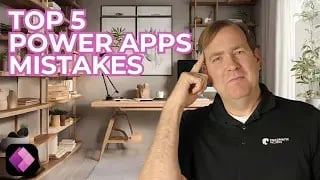5 BIGGEST Mistakes Power Apps Users Make When Starting Out!

Power Apps is an incredibly powerful low-code tool that has the potential to revolutionize business processes. However, without a strong understanding of how to avoid common mistakes, users can quickly find themselves facing roadblocks. Brian Knight shares his insights on the five most significant mistakes Power Apps users make when starting out. Avoiding these pitfalls can save time and energy, helping users build efficient and scalable applications.
1. Not Using Solutions
One of the biggest mistakes developers make when starting with Power Apps is not using solutions to organize their assets. Solutions act as a container for your applications, tables, workflows, and even chatbots. By using solutions, developers can easily move their assets from one environment to another (e.g., from development to production) without missing key components.
- Solutions make it easier to manage apps, workflows, and security settings in a single container.
- Solutions can be exported as zip files, which can then be imported into different environments.
- Without solutions, assets may be lost or improperly transferred between environments, leading to potential errors.
By organizing your assets into solutions from the start, you ensure a smoother transition between development and deployment stages.
2. Ignoring Delegation Warnings
Delegation warnings occur when Power Apps cannot translate queries into requests for the data source, especially when using data sources like SharePoint. This can result in performance issues and inaccurate data being displayed in your app. It’s crucial to pay attention to delegation warnings, which can often signal that a query is not efficiently processed by Power Apps.
- Delegation warnings can slow down app performance by pulling too much data into the app itself.
- Incorrect handling of delegation warnings can result in incomplete or incorrect data.
- Always optimize queries to avoid delegation issues, especially when using SharePoint or other limited data sources.
Brian Knight advises learning how to handle delegation warnings effectively, ensuring that your app fetches data efficiently and accurately.
3. Not Using Proper Naming Conventions
Another mistake new developers make is failing to use consistent and meaningful naming conventions. While it may seem trivial, proper naming conventions can make a huge difference when working on large applications with multiple collaborators.
- Adopting a naming convention helps identify the purpose of each component within your app.
- Using conventions like Hungarian notation allows for easier navigation and management of controls and objects.
- Without proper naming, debugging and maintaining the app can become challenging, especially for teams collaborating on a project.
Brian recommends that developers use a naming convention from the beginning, ensuring it’s consistent and understood by the entire team to avoid confusion later on.
4. Not Using Containers for Layout
Using containers to manage layouts is an essential practice in Power Apps, yet many new developers overlook it. Containers allow you to create more responsive and polished applications with minimal effort. Containers can help with both horizontal and vertical alignment, which is crucial for creating apps that look good on all screen sizes.
- Containers help manage screen layouts and ensure responsiveness, especially on mobile devices.
- Horizontal and vertical containers function like HTML div tags, making them ideal for responsive design.
- Utilizing containers improves the overall user experience, ensuring the app adapts to various screen sizes.
Containers are easy to implement and can significantly improve the appearance and functionality of your app, especially when using different devices.
5. Not Whiteboarding the Application First
Finally, one of the most critical mistakes is not whiteboarding the application before jumping into development. Sketching out the app’s layout, features, and workflows with your team or client is an essential step that often gets skipped in the rush to start coding.
- Whiteboarding allows developers and clients to agree on the app’s design and functionality before development begins.
- It helps clarify the app’s structure, reducing misunderstandings and ensuring that all requirements are captured upfront.
- Using tools like Figma can be helpful for creating mockups, but simple analog whiteboarding often proves just as effective.
By taking the time to whiteboard your app, you can identify potential roadblocks early, ensuring a smoother development process and better alignment with user expectations.
Conclusion
By avoiding these five common mistakes, new Power Apps developers can set themselves up for success. Brian Knight’s advice emphasizes the importance of planning, organization, and attention to detail, ensuring that your Power Apps projects are efficient, scalable, and user-friendly. Whether you’re new to Power Apps or a seasoned developer, these best practices will help you avoid frustrations and deliver better results.
Don't forget to check out the Pragmatic Works' on-demand learning platform for more insightful content and training sessions on Power Apps and other Microsoft applications. Be sure to subscribe to the Pragmatic Works YouTube channel to stay up-to-date on the latest tips and tricks.
Sign-up now and get instant access
ABOUT THE AUTHOR
SQL Server MVP and founder of Pragmatic Works. Brian has been working with SQL Server as a DBA and business intelligence professional since 1998. He has written more than 15 books on the topic and has spoken at dozens of conferences.
Free Community Plan
On-demand learning
Most Recent
private training







-1.png)
Leave a comment